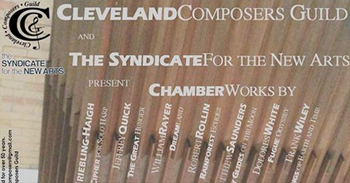by Daniel Hathaway

Performers included saxophonist Noa Even, harpist Caitlin Mehrtens, flutist Aram Mun, violinist Henry Jenkins, marimbist Louis Pino, percussionists Hunter Brown and Justin Gunter, and guitarist (and Syndicate director) Joshua Rosner. In spite of the frigid temperature inside the church, everyone played with expressive warmth and admirable digital flexibility.
Noa Even was featured in the opening solo saxophone work, Robert Rollin’s Rainforest Echoes, and she later collaborated skillfully with Hunter Brown in Matthew Saunders’ Lady Glides on the Moon.
The brief but striking Rollin piece, inspired by visits to sites in the Olympic National Park and National Forest in Washington state, evoked sounds of wildlife and wind in striking outbursts mirrored by sotto voce passages (the echoes), and called on a variety of extended techniques.
Commissioned to write a piece for clarinet, Saunders originally set out to create an homage to the seven Ohio-born Presidents of the United States. Uninspired by their careers, he turned the work into a memorial to a then-recently-departed Ohio astronaut, noting that “Neil Armstrong and the other men who landed on the moon walked: the first woman will no doubt be more graceful.” Saunders later arranged it for saxophone. Slightly belying its title, Lady is highly rhythmic, while generating a wide spectrum of colors.
Dolores White’s Fugue Odyssey gave marimbist Louis Pino (who played from memory) an energetic workout. Accurately described by the composer as “an eclectic, polyrhythmic composition that is unwavering in resolution and intensity,” the piece is mesmerizing in its synthesis of polyphony, and Pino’s multi-malleting technique was impressive to watch.
Jeffrey Quick’s Irish dance music-infused The Great Hunger, a meditation on the 19th-century Potato Famine, received a committed performance from Mun, Jenkins, and Mehrtens. At first lyrical, then animated, the piece ends with another lyrical section the composer notes “might represent the voyage to America.” Some unexpected chromaticism adds a new dimension to the Celtic material.
Caitlin Mehrtens opened the second half of the program with Margi Griebling-Haigh’s brief Cipher, described by the composer as “an episodic, code-based piece for solo harp.” Written to mark the 50th anniversary of the Bascom-Little fund, Cipher is an attractive miniature that seems to pose a puzzle, then ends suddenly with the musical equivalent of a question mark.
The highlight of the concert was Frank Wiley’s Awakenings of Earth and Time for multi-percussion solo. Though the composer wrote that the work, “very primitive in character,” makes a nod to African drumming, its form evolves from rhythmic transformations, changes in accent patterns, and fragmentations of material. The virtuosic work was rivetingly performed by Justin Gunter.
The evening ended with William Rayer’s Dreamland, “a fanciful excursion into the world of dreams where surreal events play out in our minds every night.” No particularly wild nightmares there, but Mun, Even, Rosner, Gunter, and Mehrtens realized Rayer’s nocturnal visions, underpinned by a rhythmic ostinato, in textures both clear and hazy.
All the performances bloomed in the lively acoustics of St. John’s sanctuary, one of the oldest ecclesiastical buildings in Cleveland. Though not in the best of repair, the church is an important center for the burgeoning arts community on Cleveland’s Near West Side. Bravo to the Syndicate for the New Arts for establishing a beachhead there, and to the Composers Guild for entering into such a successful collaboration.
Published on ClevelandClassical.com December 20, 2016.
Click here for a printable copy of this article



